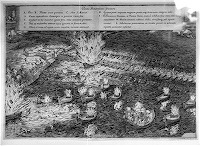 It’s right up there with music, poetry and love — since the dawn of time, mankind has heeded a primal calling to construct unstoppable, unmanned killing machines. So, today, during this Terminator week, let’s take a look back at some of those triumphs of ingenuity, the human spirit, and our inborn urge to breathe the words “Hasta la vista, baby” into the Pygmalion-warmed lips of our creations (as well as our misplaced belief they will never turn on us for our hubris).398 B.C. — The burning log rolling down a hill
It’s right up there with music, poetry and love — since the dawn of time, mankind has heeded a primal calling to construct unstoppable, unmanned killing machines. So, today, during this Terminator week, let’s take a look back at some of those triumphs of ingenuity, the human spirit, and our inborn urge to breathe the words “Hasta la vista, baby” into the Pygmalion-warmed lips of our creations (as well as our misplaced belief they will never turn on us for our hubris).398 B.C. — The burning log rolling down a hill
One of the earlier reliable mentions of one of the first reliable terminators comes from the imperial war against Carthage in Sicily by the Greek tyrant Dionysius I. While assaulting the city of Motya, the desperate citizens attempted to destroy Dionysius’ seige weapons (which were manned, and thus not proper terminators), by dropping burning logs on them. Presumably, some of them rolled down a hill of some sort.
The Romans would use rolling logs on the battlefield for centuries, and the art was finally brought to its highest point by the Crusaders, who were famous for lighting things on fire and rolling them at people from behind fortifications (I shit you not) as shown in this dramatization:
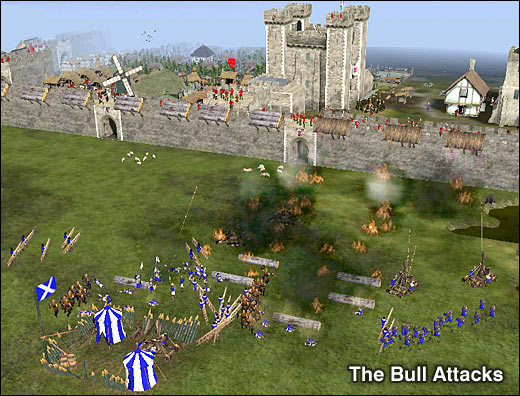
(Okay, I shit you. I also have no idea what “The Bull Attacks” means. Post your theories in the comments!)
The burning log rolling down a hill was startling in its brutal elegance — coat a log in pitch, light it on fire, and roll it down a hill. Within seconds, your average enemy Gaul or Celt or Supporter of a Rival Political Faction is confronted with a soulless, impervious death machine from which they can run, but can’t escape.
FUN FACT: The sound of a burning log bounding down a hill introduced a syncopated thumping that’s been associated with terminators ever since.
Relentlessness — High. Though passed over for far superior options in the present day, the burning log would pose a challenge even to modern soldiers – it’s impervious to small arms fire, can’t be defeated in hand-to-hand combat and is immune to a wide variety of deceptive or diversionary tactics. For thousands of years, it would be as close to the T-800 as human engineers would get – until the enemy got to the bottom of the hill.
Efficacy — High. There is no doubt these killed lots of people, and even rolled over certain victims to kill others. It’s rumored that the Roman Empire fell when a network of burning logs achieved self-awareness, bringing on the Dark Ages.
246 B.C. — Emperor Qin Shi Huang’s terra-cotta warriors
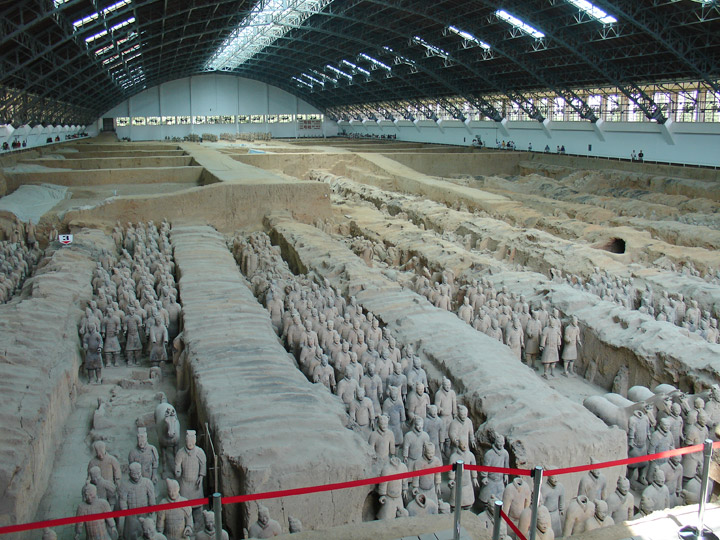
Humanity’s oldest surviving Terminators remain a gross disappointment. While breathtaking to behold, the terra-cotta soldiers were completely helpless in completing their most important task — defending the mausoleum of the Emperor Qin Shi Huang from violators.
Relentlessness — Medium. The soldiers did stand around for two thousand years waiting for their targets, so they deserve some credit. But if I were feeling ungenerous, I’d say that “vigilance” looked a whole lot like “relenting.”
Efficacy — Very low. When little Tyler Miller from Rockville, MA intruded on the emperor’s tomb with Kodak disposable cameras in 2005, the terra-cotta terminators totally failed to terminate them. Frankly, I was deeply disappointed.
OLIVER STONE MOMENT — On the one hand, they sure did get that Qin Shi guy, if that’s what they were aiming to do. Maybe the supersoldiers simply deactivated and turned to clay once the Emperor was finished off. If that’s the case, the rating goes to from very low to Overkill, which is always welcome in terminating.
1584 A.D. — The Hellburners of the Siege of Antwerp
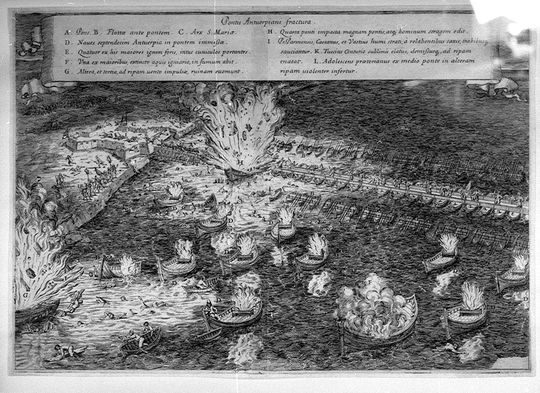
The fire ship had been terminating the high seas long before the then-Dutch, then Dutch, now-Belgian city of Antwerp was sacked in the Spanish Fury of 1576, but when Alessandro Farnese came to finish the job, it reached its most deadly form (its T-1000, if you will), with the final battle’s notorious Hellburners.
Making a fire ship is simple — take ship, set on fire, set on course for opponent, jump off. Instant soulless, relentless death ship on fire. Making a Hellburner is also simple — followsteps one through four, but between steps one and two, add hundreds of pounds of explosives.
Relentlessness — Medium. The Hellburner wouldn’t be fazed by things that would stop an ordinary ship, like ornery squids or running out of grog. It couldn’t be killed, and by the time it was in action close to the enemy, was nigh unsinkable. It pursued its target regardless of how many holes were blown into it, especially since it tended to be close to things its opponents didn’t want to have blow up when it was within range of their guns.
But once the Hellburner explodes, that’s pretty much it. It might get Sarah Connor, but it isn’t getting John in a package deal, unless he happens to be standing within a quarter-mile or so.
Efficacy — Awesome. They sure fucked up that bridge on the river Sheldt. And the Hellburner gets infinite bonus points for the name. Talk about intimidation factor.
For the record, Antwerp lost the battle, was subjugated by the Spanish, and lost 3/5 of its population. But it sure was awesome when it blew up those boats.
1945 A.D. — The Japanese Fusen Bakudan (“Balloon Bomb” a.k.a. “Fire Balloon” a.k.a. “This Actually Happened”)
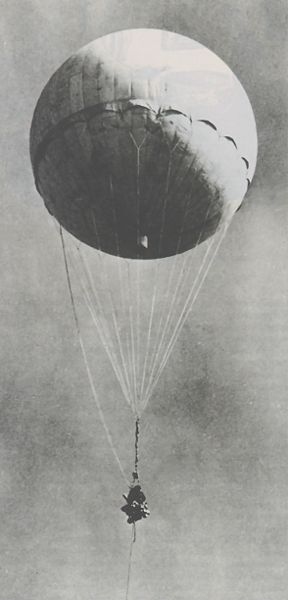
The world wars saw the widespread use of a variety of automated hunter-killers — the V1 rocket (more hunter, less killer) and the cloud of poison gas (more killer, less hunter) come to mind. But none show true progress in the human search for termination quite like the “fusen bakudan,” the Japanese balloon bomb. We call them “fire balloons.”
Between November 1944 and April 1945, the Japanese launched 9,000 hydrogen-filled balloons all the way across the Pacific Ocean to attack the continental United States. The brilliant little devices used timed ballast releases and the jet stream to hunt their target (a big one, natch) for weeks, only to drop their ballast and blow up when they land somewhere, anywhere in America. And yes, some of them hit home, blasting holes in, well, usually unpopulated forest in the Pacific Northwest. But they were found as far east as Michigan.
Relentlessness — Exceptional. Not even the T-X could cross the Pacific Ocean on its own power. Although I’m sure the director would give us plenty of gratuitous robot bikini shots if it tried.
Efficacy — Very low. Covered up by the U.S. office of the censor and cut short by the end of the war, the program never quite made the top-ten list of wartime innovations — and there is the matter of its 0.067% kill rate. But they sure did get that little girl who found one in a tree and tried to get it down. Good one there, Japan. Nice.
HARRY TURTLEDOVE MOMENT — But if those balloons had been loaded with chemical weapons, the story could have been a lot different. Yay for fair play.
2008 A.D. — The Boeing X-45
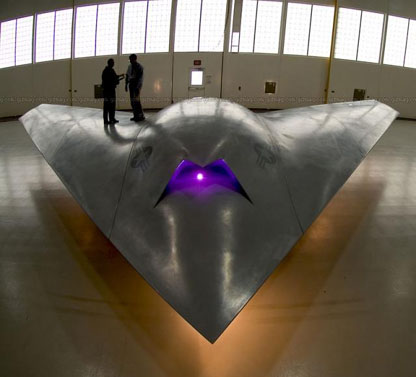
Suffice it to say that I don’t want to say too much about the United States’ upcoming unmanned fighter jet with autonomous capability, because I don’t want it or its robotic, gun-toting brethren to pay me a visit. But yeah, the more familiar Predator is remote-controlled. The X-45 can actually fly and fight and kill all by its lonesome. Of course, it can be controlled remotely — when it or something like it is put into use, its autonomous capability will be pure gravy, with no potential drawback at all.
Of course, I did see Stealth, and that movie was so bad that I suppose I have very little to fear from autonomous military aircraft.
Relentlessness — High. The Predator can stay in the air for more than 24 hours straight and fire missiles at you. And it doesn’t even have the icy persistence of infallibe robot logic. The X45 and their successors look like they’re in the hunt for the long haul.
Efficacy — Debatable. Perhaps if it were programmed to say “I’m looking for Osama Bin Laden” in an Austrian accent . . .
Re: “The Bull Attacks”
The only possibility I can think of, is that when the blue army’s charge gets close to the fortifications, the red side is somehow whisk its entire castle aside in a flawless veronica, allowing the metaphorical “bull” to careen onwards into the ocean.
In any case, “The Bull Attacks” would be an awesome name for a metal song. Or a metal band. Or the lead vocalist of a metal band.
No mention of the most important possible feature for the Boeing X-45 in relation to Stealth. Can the X-45, too, download every song ever from the Internet? If so, consider the RIAA also terminated.